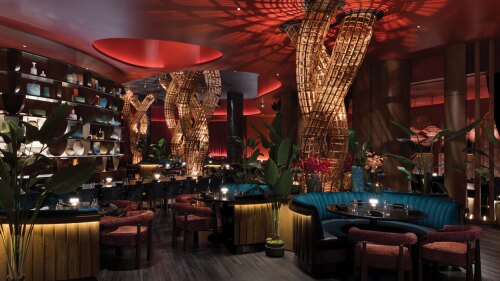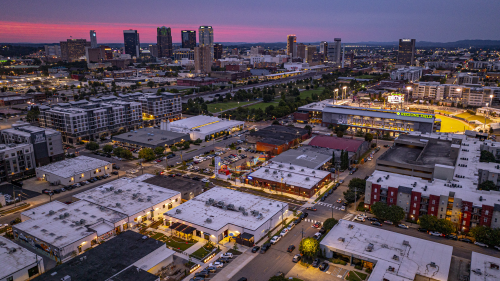Property Types
Hotels and Resorts
The hotel industry in the United States faces complex challenges in 2025, according to Jan Freitag, national director of hospitality analytics for the CoStar Group. During the “State of the U.S. Hotel Industry” presentation at the ULI 2025 Spring Meeting in Denver, Colorado, Freitag highlighted the challenges facing the hotel business amid macroeconomic uncertainty.
Once a sprawling expanse of uncharted land, Las Vegas, Nevada, has evolved into the entertainment capital of the world, a gaming super-hub, and a premier destination for sports. This remarkable transformation didn’t happen overnight; it stemmed from decades of strategic planning, investment, and visionary zoning recommendations.
Las Vegas is unlike any other place in America. Each year it draws more than 40 million visitors to the dazzling casinos and hotels that “turn night into daytime”—and transform the city into a glittering jewel in the desert. With 164,000 hotel rooms, Las Vegas is the largest hospitality market in the U.S.—outpacing Orlando, Florida, the next biggest market, by approximately 15 percent, according to JLL.
Industrial
Standing in the shadow of Regions Field and within earshot of Railroad Park, Birmingham’s Urban Supply hints at what the next chapter of downtown life could look like. Once-quiet brick warehouses are being steadily reimagined into patios, storefronts, and gathering spaces along a new pedestrian alley. Early tenants have begun to open their doors, and programming is slowly bringing people into the district. While the project is still in its early stages, the framework is in place for a vibrant hub that will grow block by block in the years ahead.
What trends are shaping the future of the industrial sector? Four experts from ULI’s Industrial and Office Park Development Council talk about the industrial submarkets and property types that offer the greatest opportunities, challenges developers face in bringing new projects to market, ways artificial intelligence and emerging technologies are reshaping the sector, tenant priorities, and other key trends.
After a quiet first half of 2024, CMBS originations increased 59 percent in Q3 on a year-over-year basis, according to the Mortgage Bankers Association’s Quarterly Survey.
Mixed-Use
“The Food Revolution and Its Impact on Real Estate”—a session at ULI’s recent 2011 Fall Meeting—showcased three different examples of how food is becoming an increasingly important part of not just our diets, but also our developments. Read more to learn how this panel provided food for thought on the role of food as a real estate amenity, a community builder, and a project differentiator.
Despite the deepest economic recession since the 1930s, small-scale entrepreneurs are finding creative ways to develop and finance both commercial and residential real estate projects—and occasionally even make money. Find out what two such entrepreneurs told the audience at a recent ULI 2011 Fall Meeting session titled “Small-Scale Development: Entrepreneurship in the Post–Credit Crunch World.”
The urban landscape of Hong Kong has become increasingly dominated by large-scale podium developments, the most recent of which often have little or no functional relationship to the urban street grid. Read what makes up the ULI Ten Principles for a Sustainable Approach to New Development, created with the aim of influencing future development in Hong Kong and the region.
Multifamily
At the beginning of a panel discussion at the ULI Fall Meeting in New York City, a moderator asked the audience to raise their hands if they thought the apartment business was headed for a bust. At the end of the session, the moderator asked the question again—and the number had doubled.
Why one innovative housing development in the Rockaways withstood the waves.
Once preferring office and retail, international investors are starting to see multifamily rentals as a valuable, stable asset class, said panelists at the 2014 ULI Spring Meeting.
Office
According to a new report from CBRE Research, annual tenant demand, as measured by net absorption, totaled 52.7 million square feet (4.9 million sq m) in 2014—the highest annual amount since 2007.
As panelists demonstrated at the 2014 ULI Fall Meeting, owners and developers are generating new demand for office space by repositioning entire neighborhoods and developing new mixed-use buildings to meet the needs of office users.
Prevailing modes of workplace organization have and continue to be upended by new enterprises, designers, and clients, according to panelists at the 2014 ULI Fall Meeting in New York City.
Residental
In his recently released book, Evicted: Poverty and Profit in the American City, sociologist and 2016 MacArthur Fellow Matthew Desmond explores life for low-income renters and their landlords in two high-poverty Milwaukee communities. How Housing Matters spoke with Desmond about his research and its implications for housing policy.
The finalists for this year’s ULI Robert C. Larson Housing Policy Leadership Awards include Arlington County, Virginia, the City of Chicago, Illinois, New York City, and the State of Iowa.
Small apartment buildings are often overlooked or underserved by housing policy and traditional housing and commercial real estate finance mechanisms. Because this housing type is so prevalent in New England and important in the state’s housing stock, the Connecticut Housing Finance Authority has created a three-pronged program to address rental needs at a scale that works for the state’s smaller communities.
Retail
For decades, civic leaders have tried to revitalize Market Street, San Francisco’s central thoroughfare, only to see their efforts founder. “I sometimes call it the great white whale of San Francisco,” says Eric Tao, managing partner at L37 Development in San Francisco and co-chair of ULI San Francisco. “Every new mayor, every new planning director, every new economic development director has chased that white whale.” This year, however, an international competition of ideas hosted and run by ULI San Francisco, with support from the ULI Foundation, generated fresh momentum for reimagining the boulevard. The competition drew 173 submissions from nine countries and sparked new conversations about the future of downtown San Francisco.
The OAK project began in 2009, when a development firm set their sights on the corner of Northwest Expressway and North Pennsylvania Avenue, the state’s most important and busiest retail intersection. As the region’s only parcel capable of supporting a vertically integrated project of this scale and density, that land represented an opportunity to create something truly special.
As aging retail continue to evolve, one increasingly popular trend has been to redesign malls as town centers—recalling a time when such commercial districts were the heart and soul of a community. Mall–to–town center retrofits are emerging throughout the nation, especially in suburban communities, where pedestrian-friendly, mixed-use environments are highly attractive to millennials now raising families.



















